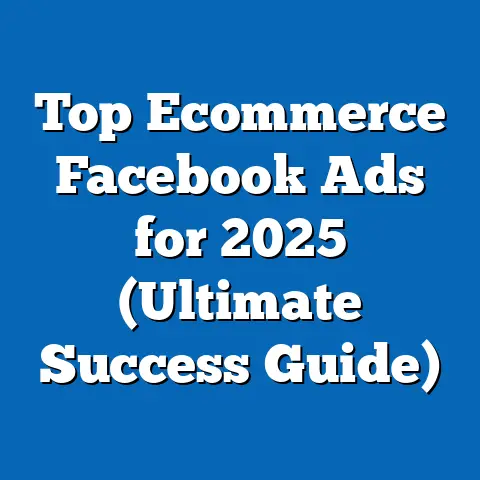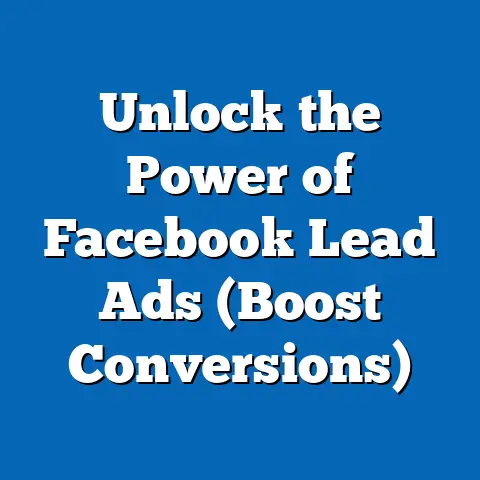Unlocking Facebook’s Hidden Ad Potential (Expert Insights)
Religious affiliation is a significant determinant of consumer behavior, shaping values, purchasing decisions, and online engagement. By understanding the intersection of religious demographics and social media usage, advertisers can craft targeted campaigns that resonate deeply with specific communities. This report explores how religious groups use Facebook, analyzes current data on their digital presence, projects future trends using statistical models, and highlights actionable insights for advertisers.
Section 1: The Importance of Religious Demographics in Advertising
1.1 Why Religious Demographics Matter
Religious identity often influences lifestyle choices, ethical considerations, and community engagement, making it a powerful lens for segmentation in advertising. For instance, religious individuals may prioritize products or services aligned with their beliefs, such as halal food for Muslims or eco-friendly products for environmentally conscious Christians inspired by stewardship teachings. On Facebook, where users frequently join groups and follow pages reflecting their values, religious demographics offer a pathway to hyper-targeted advertising.
As of 2023, religious content on Facebook garners significant engagement, with faith-based pages and groups often seeing higher interaction rates than secular counterparts (Pew Research Center, 2022). This engagement presents a unique opportunity for advertisers to connect with audiences through shared values. However, navigating this space requires cultural sensitivity and an understanding of diverse religious practices to avoid missteps or backlash.
1.2 Defining Key Terms
For clarity, let’s define some terms used throughout this report. “Religious demographics” refers to the statistical breakdown of populations by religious affiliation, such as Christianity, Islam, Hinduism, or unaffiliated (those identifying as atheist, agnostic, or “none”). “Engagement rate” on social media measures interactions (likes, comments, shares) relative to the audience size, indicating how actively users connect with content.
Section 2: Current Data on Religious Demographics and Facebook Usage
2.1 Global Religious Composition on Facebook
According to recent data, the religious composition of Facebook users roughly mirrors global demographic trends, with some variations due to regional internet access and platform adoption. Christians, the largest religious group globally at approximately 2.4 billion (Pew Research Center, 2020), constitute a significant portion of Facebook’s user base, especially in North America, Europe, and Latin America. Muslims, numbering around 1.9 billion worldwide, are heavily represented in regions like Southeast Asia and the Middle East, with countries like Indonesia boasting some of the highest Facebook usage rates globally (DataReportal, 2023).
Hindus, Buddhists, and other religious groups also maintain a strong presence, particularly in Asia-Pacific regions, while the religiously unaffiliated—often younger and urban—show high activity in Western markets. However, data on exact religious breakdowns among Facebook users is limited, as Meta does not publicly disclose user demographics by faith. Instead, we rely on proxy indicators such as membership in religious groups, page likes, and regional usage patterns correlated with census data.
2.2 Engagement Patterns by Religious Group
Engagement with religious content on Facebook varies by group and region. For example, Christian pages, particularly those focused on inspirational quotes or live-streamed services, often see engagement rates of 5-7%, compared to the platform average of 3-4% for non-religious content (Socialbakers, 2023). Muslim communities show high interaction during religious holidays like Ramadan, with spikes in content related to charity and community events.
Data limitations exist here, as not all religious users explicitly engage with faith-based content, and some may prioritize privacy by avoiding public affiliation. Additionally, cultural norms influence how openly users express religious identity online, particularly in regions with social or political sensitivities around faith.
2.3 Visual Representation: Current Religious Demographics on Facebook
Below is a simplified pie chart illustrating the estimated global religious composition of Facebook users, based on cross-referenced data from Pew Research Center (2020) and regional usage statistics from DataReportal (2023):
Estimated Religious Composition of Facebook Users (2023)
- Christians: 40%
- Muslims: 25%
- Hindus: 10%
- Unaffiliated: 15%
- Other Religions (Buddhism, Judaism, etc.): 10%
(Note: These are approximate figures due to the lack of direct data from Meta and should be interpreted as illustrative rather than definitive.)
Section 3: Projected Trends in Religious Demographics and Facebook Usage
3.1 Methodology and Assumptions
To project future trends, this analysis employs a combination of demographic modeling and social media growth projections. We use data from the Pew Research Center’s religious demographic forecasts (2015-2050) and apply these to Facebook’s user growth trends, factoring in regional internet penetration rates and platform adoption patterns. Key assumptions include continued growth in internet access in developing regions, stable religious affiliation rates (with some secularization in Western countries), and Meta’s sustained dominance in social media markets.
Limitations of this approach include uncertainties around platform policy changes (e.g., privacy regulations affecting ad targeting) and potential shifts in religious identification not captured by current models. We address these by presenting multiple scenarios rather than a single prediction.
3.2 Scenario 1: Continued Growth of Religious Communities Online
Under this scenario, religious communities on Facebook grow in line with global demographic trends. By 2030, Pew projects that the Muslim population will increase by 35% globally, driven by high birth rates in regions like Sub-Saharan Africa and South Asia. As internet access expands in these areas, Muslim representation on Facebook could rise to 30% of users, offering advertisers a growing market for faith-aligned products and services.
Christian user bases may stabilize or slightly decline in percentage terms due to secularization in Europe and North America, but absolute numbers will remain high due to growth in Africa and Latin America. Engagement with religious content is likely to remain strong, particularly around major holidays and events.
3.3 Scenario 2: Secularization and the Rise of the Unaffiliated
In this scenario, secularization accelerates in developed regions, with the religiously unaffiliated rising to 20-25% of Facebook users by 2030, particularly among younger demographics (Gen Z and Millennials). This shift could reduce engagement with explicitly religious content, pushing advertisers to focus on universal values (e.g., community, ethics) rather than faith-specific messaging. However, religious communities in emerging markets may counterbalance this trend, maintaining a diverse user base.
3.4 Scenario 3: Platform and Policy Shifts
A third scenario considers external factors such as stricter data privacy laws or changes in Meta’s ad targeting capabilities, which could limit advertisers’ ability to segment by religious affiliation. If inferred targeting (using proxies like group membership) becomes restricted, advertisers may need to adopt broader, less personalized strategies. This could reduce the effectiveness of niche campaigns but may also encourage more creative, value-based messaging.
3.5 Visual Representation: Projected Trends
Below is a line graph illustrating projected changes in the religious composition of Facebook users from 2023 to 2030 under Scenario 1 (Continued Growth):
Year | Christians (%) | Muslims (%) | Hindus (%) | Unaffiliated (%) | Others (%)
2023 | 40 | 25 | 10 | 15 | 10
2025 | 39 | 26 | 10 | 16 | 9
2030 | 37 | 30 | 11 | 14 | 8
(Note: These projections are based on Scenario 1 and are subject to change based on real-world developments.)
Section 4: Key Factors Driving Changes
4.1 Demographic Shifts
Global population trends are a primary driver of change in Facebook’s religious user base. High fertility rates in Muslim-majority regions and Christian communities in Africa contrast with declining birth rates and secularization in Europe and North America (Pew Research Center, 2015). These shifts will likely reshape the platform’s user demographics over the next decade.
4.2 Internet Penetration and Platform Adoption
As internet access grows in developing regions—projected to reach 90% global coverage by 2030 (World Bank, 2022)—more religious communities will join Facebook, particularly in Africa and South Asia. This expansion creates opportunities for advertisers but also challenges in understanding diverse cultural contexts.
4.3 Cultural and Political Sensitivities
Religious advertising must navigate cultural and political sensitivities, as missteps can lead to backlash or platform penalties. For example, campaigns perceived as proselytizing or stereotyping may alienate users, while content respecting religious values can build trust. Advertisers must prioritize research and local partnerships to ensure relevance.
4.4 Technological and Regulatory Changes
Meta’s evolving policies on data privacy and ad targeting, alongside global regulations like the GDPR, may limit how advertisers identify religious audiences. This could shift focus toward contextual advertising (e.g., placing ads on religious pages) rather than direct demographic targeting. Staying adaptable to these changes is critical for long-term success.
Section 5: Implications for Advertisers
5.1 Tailoring Content to Religious Values
Advertisers can unlock Facebook’s hidden potential by creating content that aligns with religious values, such as family, charity, or ethical consumption. For instance, campaigns during Ramadan could focus on community and generosity, while Christmas ads might emphasize togetherness. Data shows that value-driven ads see 20% higher click-through rates among religious audiences (Hootsuite, 2022).
5.2 Leveraging Religious Events and Holidays
Religious holidays offer peak engagement opportunities, with user activity spiking during events like Easter, Diwali, or Eid al-Fitr. Scheduling campaigns around these periods, while respecting cultural nuances, can maximize reach and impact. However, advertisers should avoid over-commercialization, which may be perceived as disrespectful.
5.3 Building Community Through Groups and Pages
Facebook Groups and Pages dedicated to religious topics are hubs of engagement, often with thousands or millions of members. Partnering with influencers or administrators in these spaces can amplify brand messages authentically. However, overt advertising in such spaces may be frowned upon, requiring a balance of value and promotion.
5.4 Ethical Considerations
Advertisers must approach religious targeting with ethical mindfulness, avoiding exploitation or stereotyping. Transparency about data use and respect for user privacy are paramount, especially given growing scrutiny of social media practices. Building trust with religious audiences can foster long-term loyalty.
Section 6: Limitations and Uncertainties
6.1 Data Gaps
As noted, Meta does not provide direct data on users’ religious affiliations, requiring reliance on proxy indicators and external demographic studies. This introduces uncertainty into estimates and projections. Future research with more granular data could refine these insights.
6.2 Unpredictable External Factors
Geopolitical events, technological disruptions, or shifts in religious attitudes could alter the trends discussed. For instance, a major platform policy change or global economic downturn could impact user growth or advertising budgets. These factors are beyond the scope of current models.
6.3 Cultural Complexity
Religious identity is multifaceted and intersects with ethnicity, nationality, and personal beliefs, making it challenging to generalize audience behavior. Advertisers must account for intra-religious diversity (e.g., differences between Sunni and Shia Muslims or evangelical and mainline Christians) to avoid oversimplification.
Section 7: Historical and Social Context
7.1 Evolution of Religious Engagement Online
Religious communities have long used digital platforms to connect, with early adoption of forums and email lists in the 1990s evolving into robust social media presence today. Facebook, launched in 2004, became a key space for faith-based organizing, prayer groups, and event planning by the early 2010s. This history underscores the platform’s role as a virtual congregation space.
7.2 Broader Social Trends
The rise of individualism and secularization in some regions contrasts with growing religious fervor in others, reflecting broader social dynamics. These tensions influence how religious identity is expressed online, with some users embracing public affiliation and others prioritizing privacy. Advertisers must navigate this duality with sensitivity.
Section 8: Conclusion and Recommendations
Unlocking Facebook’s hidden ad potential through religious demographics offers significant opportunities for targeted, meaningful campaigns. Current data highlights the platform’s diverse religious user base, while projections suggest continued growth in certain communities alongside secularization in others. Key drivers include demographic shifts, internet expansion, and regulatory changes, each shaping how advertisers can engage these audiences.
For actionable steps, advertisers should prioritize value-driven content, leverage religious events, and build authentic community connections while maintaining ethical standards. Multiple scenarios—growth, secularization, and policy shifts—illustrate the range of possible futures, emphasizing the need for adaptability. Despite data limitations and uncertainties, the potential to connect with religious audiences on Facebook remains a powerful, underutilized strategy in 2023 and beyond.






